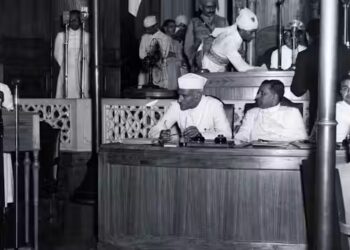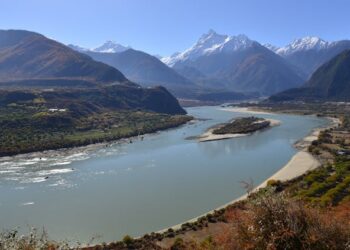As I turn the first pages of this book, I find myself listening to ‘Raavi’ by the legendary Pakistani artist Sajjad Ali, seated in a cafe thousands of miles away from both India and Pakistan. Here in Sydney, Australia – a ‘neutral’ diasporic space – the usual preconceived and predominant notions lose their sharpness. Through the book’s scholarly and nuanced analysis, Hindi cinema emerges as a symbolic ‘Raavi’ connecting the two ‘sensible nations’ in my mind. Like two shores of the same river – together yet apart, with little hope of merging.
“..both these nations, Hindustan and Pakistan, are children of the same
mother. As of now they are lying down with their backs to each other.”
Despite shared culture, language and traditions, the divide remains deepened and fraught with historic political rifts. Yet, the cinema-river, sometimes quiet and at other times roaring, flows between the two like “the hidden wishes of a vast number of people, a group dream, collective fantasy”, serving as an honest witness to the profound significance of the many themes and perspectives woven into the portrayals of the complex and troubled chapters of the two shores.
And the initial questions that come to mind are…
- Can the Hindi cinema-river be apolitical and well-balanced to the two shores?
- Can it be sympathetic and sensitive while sticking with facts?
- Can it prod perspectives and be a true barometer of the breadth and depth of the complex issues that lie at the intersection of deep cultural similarities and even deeper political differences?
- Can it bring dignity and depth that the subject deserves, while mindfully portraying uncontainable sibling rivalry and bittersweet dynamics of fluctuating political relationships?
- Can it be entrusted for recording history, making history and directing it?
“There has been no more honest witness to the multihued relationship than Hindi cinema”, Meenakshi Bharat’s unwavering assertion of the role of Hindi cinema as a highly perceptive cultural witness to the India-Pakistan equation is reinforced by a thoughtful discourse spanning 196 pages and nearly a hundred Hindi films in this book. These films explore a vast number of themes – ranging from wars and border disputes to proxy wars on cross-border terrorism, the discontent amongst the disaffected youth to sports rivalries, cross-border romances, humour, and the aftermath of the wartime victories.
In an ambitious undertaking, Bharat’s meticulous examination of Pakistan in Hindi cinema stands as a detailed and insightful study of a topic that never loses its sheen and that continues to captivate filmmakers since 1950s – inspiring many narratives shaped by their diverse biases, ideologies and perspectives.
The topic of the Partition evokes multitudes of reactions in Indians and Pakistanis. From bitter recollections of deep wounds and hostility, political discourses on both historical and ongoing conflicts to a deep sense of longing for the lost gali and ghar and shared cultural history – it is a topic that demands a portrayal that is as nuanced and balanced as it is sensitive. A portrayal that acknowledges but not over-pitches the patent acrimony, and that certainly does not bypass the many unexpected cross-border love stories and the intertwined destinies of the two nations…
The book artfully explores how Hindi cinema endures this challenge and whether it holds transformative power in shaping understanding and fostering connection. It is at once an austere and entertaining study that elevates the contribution of Hindi cinema to a literary stature.
In chronicling the 95 movies and untangling the themes they cover, the book masterfully offers both a close-up and wide-angle lens to appreciate the intricate layers of the psychological, political, cultural, social and moral landscapes of the India-Pakistan equation in Hindi cinema. In doing so, it celebrates Hindi cinema’s contribution in making space for fresh and balanced frontiers for future engagement between the two.
“What our government cannot do, our cinemas can..”:
While the book chronicles countless cinematic portrayals of trite jingoism in Hindi cinema, it also includes those cinematic efforts that have tried to avoid the stereotypical angle and portrayed fresh metaphorical takes for cathartic effect. A good number of such films that now feature in my newly created watch-list, thanks to Bharat’s insights, include Pinjar that “identifies the woman’s body as the ravaged battlefield on which men from either side wage their battle, highlighting that it is women who paid the heaviest price at the time of Partition”; Bhaag Milkha Bhaag, where “his emotional scars are indicative of the scars the nation carries from the partition”; and Refugee where the child becomes “a metaphor for hopeful recuperative integration of those who have been torn asunder by contesting national identities”.
Bharat has also spotlighted a refreshing cinematic theme that, on the surface, may appear incapable of maintaining the gravitas to tackle the ups and downs of the fraught relationship between the two nations yet it can serve as the “preferred vehicle to deal with the weightiest issues and their critique of India-Pakistan relationship”. That theme is humour. Films such as Tere Bin Laden or Total Siyapaa reveal that the lens of humour can be successfully wielded against the widely accepted “kind, understanding lens” to offer a “serious podium for staging cultural criticism.”
As Bharat asserts, “The co-option of comedy is specifically designed to lighten the terror pervaded atmosphere and to relieve the gravity of the subject without trivialising the problematic of the difficult relations between the two countries.”
Humour, love, metaphorical depictions are vital ingredients of a mindful and well-considered representation of this bitter-sweet relationship and of the undeniable pull of cultural oneness. These themes allow embracing the complexity rather than resorting to the simplistic, aggressive stereotype of Pakistan bashing.
Although a runaway hit, films like Gadar underscore filmmakers’ tendency to oversimplify and succumb to jingoism. But the book reveals that a heartening number of films strive to achieve a balance and that the cumulative power of all the films taken together signals that something significant is happening here.
“..even as a Gadar or a Pathaan set the cash registers ringing, there is a Garam Hawa, Mammo, Tamas, Haider or a Tahaan to balance the picture.”
Hindi Cinema and Pakistan is undoubtedly a serious exploration that provides multi-pronged evidence should there be enquiries into the evolution of themes in Hindi cinema and whether they reveal a growth progression or a transformation in the national mindset.
The book is a great read for avid cinema goers, film-historians, film-archivists and everyone who has been directly or indirectly impacted by the Partition.
I want to leave you with this quote from Shershaah that had me in splits: ‘Give us Madhuri Dixit. I swear by Allah, we will all retreat’, which lightheartedly yet effectively underscores how Hindi cinema-river can bridge the chasm between the two shores using a cultural platform and ropes of humour!
P.S: I learnt about Sajjad Ali from a Pakistani musician and a good friend, Sadiq Rehmani, who idolises Kishore Kumar.
In Sydney, I interact with many Pakistani friends through music, social events, and professional settings. Our shared language, culture, music and customs create an instant bond. For those who speak Hindustani, this connection is often deeper than the one we can form with other South Asians, such as Sri Lankans, Bangladeshis, Nepalese, or Bhutanese.
About Raavi: This song speaks of the longings of someone who has created a home away from home but deeply yearns his homeland. Despite their longing and willingness to return, various circumstances prevent them from doing so. Reminiscing his homeland, he wishes Raavi to flow in his adopted country…
Je aithon kadi raavi langh jaave, Hayati punj aabi ban jaave
Main bediyan hazaar tod laan, Main paani cho saah nichod laan
My Watchlist: Dhoop, Pinjar, Mammo, Begum Jaan, Roja, Raazi, Haider, Yahaan, Tere Bin Laden, Filmistaan, Refugee, Pukar, Vijeta, Garam Hawa, Bhaag Milkha Bhaag.











